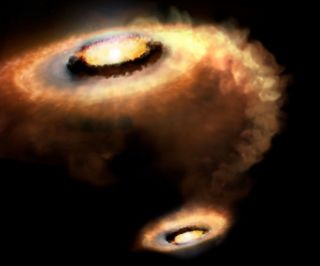 T Tauri stars are a class of variable stars, named for their prototype T Tauri, discovered in 1852. T Tauri stars have been known for decades as relatively normal, medium-sized, extremely young main-sequence stars. At one point, some 4.5 billion years ago, our Sun was a T Tauri star. T Tauri stars are thought to be surrounded by protoplanetary disks, containing the raw materials to build both rocky and gaseous planets. Though nearly invisible in optical light, these disks shine in both infrared and millimeter-wavelength light.
T Tauri stars are a class of variable stars, named for their prototype T Tauri, discovered in 1852. T Tauri stars have been known for decades as relatively normal, medium-sized, extremely young main-sequence stars. At one point, some 4.5 billion years ago, our Sun was a T Tauri star. T Tauri stars are thought to be surrounded by protoplanetary disks, containing the raw materials to build both rocky and gaseous planets. Though nearly invisible in optical light, these disks shine in both infrared and millimeter-wavelength light.
Some T Tauri stars emit infrared radiation in unexpected ways. Those stars were the focus of this study, led by astronomer Colette Salyk at the National Optical Astronomical Observatory (NOAO) in Tucson, Arizona. Many T Tauri stars have been thought to have extremely powerfulstellar winds – predicted by astronomers, but never clearly detected – and Salyk and her team proposed that, for some T Tauri stars, the winds may be emanating from within the stars’ protoplanetary disks. They say these winds could have important implications for planet formation, potentially robbing the disk of some of the gas required for the formation of giant Jupiter-like planets, or stirring up the disk and causing the building blocks of planets to change location entirely.
Read the full story at EarthSky
Read the press release from NRAO

